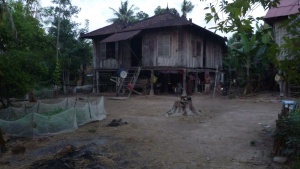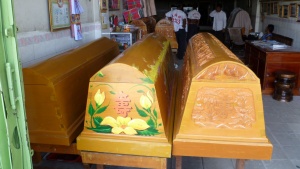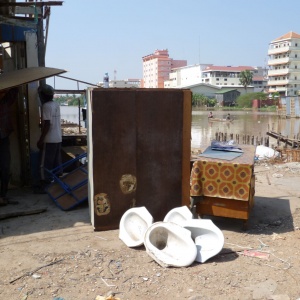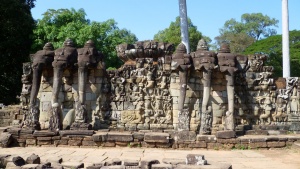Flags are flying in the streets of Phnom Penn today. There is little 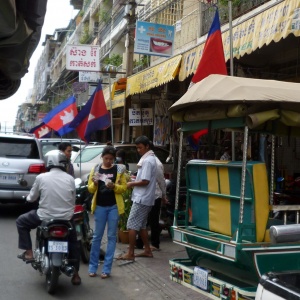 evidence of celebration. Today is January 7th, Liberation from Genocide Day, the day when Vietnamese troops joined Cambodians and overthrew Pol Pot’s murderous Khmer Rouge regime. Strange, there is no show of military might, no massed parades, not even a small marching band and street parade, simply national flags bearing the unmistakable towers of Angkor lining the more important streets and boulevards of Cambodia’s capital. There is a sense of quiet reverence for the millions of lost souls who perished during the reign of terror. In some quarters, political dissidents of the current ruling communist party see no cause for celebration. They believe the country has capitulated once more and merely replaced one tyrant for another. The tyrant is Vietnam where strings are pulled in Hanoi and the Cambodian puppets dance.
evidence of celebration. Today is January 7th, Liberation from Genocide Day, the day when Vietnamese troops joined Cambodians and overthrew Pol Pot’s murderous Khmer Rouge regime. Strange, there is no show of military might, no massed parades, not even a small marching band and street parade, simply national flags bearing the unmistakable towers of Angkor lining the more important streets and boulevards of Cambodia’s capital. There is a sense of quiet reverence for the millions of lost souls who perished during the reign of terror. In some quarters, political dissidents of the current ruling communist party see no cause for celebration. They believe the country has capitulated once more and merely replaced one tyrant for another. The tyrant is Vietnam where strings are pulled in Hanoi and the Cambodian puppets dance.
Prime Minister Hun Sen loudly decries these accusations with wild tirades publicly denouncing his dissenters, as he signs off on another land deal. This time with a Chinese company to a lakeside re-development project effectively displacing over 4000 Khmer families from their homes. Communities that have been scratching out a living for decades.
Phnom Penh, situated at the confluence of three massive rivers, Tonle Sap, Tonle Bassic, and the Mekong, is a dusty city. Sand and grit sweep through the streets in efforts to rebuild itself. Not a large city in size but densely populated. Infrastructure struggles to gain a toe-hold. A city constantly under construction. Some days it seems a city on its knees, about to concede and give in to the demands a busy populace makes on it. Always on the move, not fast, but thick. A constant ebb and flow. I doubt traffic ever comes to a complete standstill.
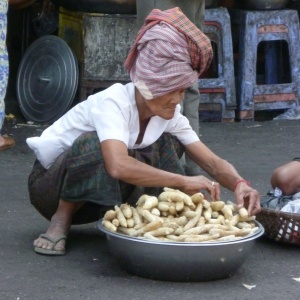 Poke around in local produce markets to taste what daily life is like for Khmers or wander the multi-storied Wong Wong City Mall. Marvel at the elegant lines of traditional Khmer Kingdom architecture at places like the National Museum, Wat Phnom, or various pagodas dotted throughout the city, much of which sits side by side with rapid development like Naga World the five-star casino and hotel complex. A city run by big government where there is a department, directorate, inspectorate, bureau, or ministry of everything, and an oversized building to accommodate it.
Poke around in local produce markets to taste what daily life is like for Khmers or wander the multi-storied Wong Wong City Mall. Marvel at the elegant lines of traditional Khmer Kingdom architecture at places like the National Museum, Wat Phnom, or various pagodas dotted throughout the city, much of which sits side by side with rapid development like Naga World the five-star casino and hotel complex. A city run by big government where there is a department, directorate, inspectorate, bureau, or ministry of everything, and an oversized building to accommodate it.
Phnom Penh, indeed Cambodia, does not interest first world powers or multi-national businesses with nothing here to exploit; no massive population to chain to manufacturing, no natural or mineral resources to plunder. It’s been widely overlooked. Surrounded by countries of massive populations and growing wealth Cambodia is the navel of Asia, poke around inside you find where lint collects. Immediate neighbours, Vietnam and China have a noticeable presence. South Korea is emerging now with construction of national roadways and “friendship” bridges over the Mekong River, a rift grows deeper between Thailand, sharing a border to its west.
Cambodia has a restored monarchy. Rumour alleges King Norodom Sihamoni is gay, a detail of little or no interest to the population in the Kingdom of Wonders. The monarchy runs alongside the communist Cambodia People’s Party led Hun Sen who wields power unchallenged and unchecked. Hun Sen is perturbed by homosexuality. He formally disowned a daughter in 1997 when she publicly came out as a lesbian. Obviously, it is one thing to be gay and royal, not so much to be gay and part of a powerful political dynasty. Sen, a former five-star general, has made his son a two-star general, a move to secure the dynasty, not unlike North Korea. This son was educated in the West striking hope having had a taste of democracy he’ll demonstrate a more tolerant and humane form of leadership. Most Khmers live in fear of authority be it political, civil (military) or civic (police). Given its modern history there is evidence and provocation to be so.
The ruling party would have you believe Cambodia runs on democratic principles, that communist ways of old served their purpose now the country is ready to stand alongside major Asian powers. Ask this of striking garment factory workers, the garbage collectors, the 4000 families removed by force from their homes at Boeung Kak Lake. Change is coming but it will be slow. A new political force made itself known in the recent national elections. A second voice heard, continuing to gather momentum. It is the voice of the disenfranchised majority. Emerging from the political wilderness, the Cambodia National Rescue Party under Sam Rainsy’s leadership captured 45% of the national vote. The first serious challenge to Hun Sen’s decades of absolute power was shaken, though not dislodged. With a five-year cycle of government fears his voice of opposition will be eradicated by one means or another come next election.
Cambodia exists on a largely agricultural (rice) based economy, while 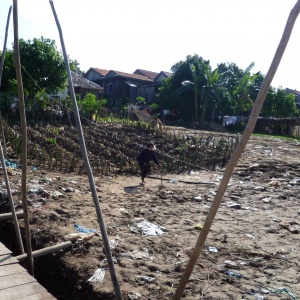 operating a dual monetary system of US dollars and the local currency, Riel. Producing two rice crops a year an average Khmer farmer can expect between $US500 to $US700 a year. Farmers believe prices are manipulated by Thailand where rice is their primary export, making them a major global supplier. Mismanagement of a government rice subsidy project in Thailand created a slump in rice prices. Enterprising Khmers, geographically advantaged by proximity to Vietnam, ferry large quantities of unprocessed grain in the dead of night across the border and sell for a higher cash price.
operating a dual monetary system of US dollars and the local currency, Riel. Producing two rice crops a year an average Khmer farmer can expect between $US500 to $US700 a year. Farmers believe prices are manipulated by Thailand where rice is their primary export, making them a major global supplier. Mismanagement of a government rice subsidy project in Thailand created a slump in rice prices. Enterprising Khmers, geographically advantaged by proximity to Vietnam, ferry large quantities of unprocessed grain in the dead of night across the border and sell for a higher cash price.
The on-going debate nationwide for Khmer’s is the issue of land rights. In the city and provinces grabs for land are a recurring practice. Proving ownership of property is a constant battle when sections of land are financially desirable by a cashed up prospective buyer. Occupied land is suddenly deemed “state-owned” and with little notice appears on the market. Dates for re-location are sudden; compensation is a token gesture at best, before bulldozers move in to raze the lot.
On this day of national celebration and remembrance, 300 residents from Village 4 at Boeung Kak lakeside are meeting in Freedom Park, Phnom Penh’s designated “free speech” zone, to protest their eviction. In a remote village in Pray Veng province the headman from one village is neatly attempting to steal a couple of hectares of rice farm right out of the hands of an elderly mother who lives in the adjoining village. All that stands between them is a thumb print on a dusty old document that denotes land ownership. Literacy, or lack of it, is a major developmental stumbling block for Khmers.
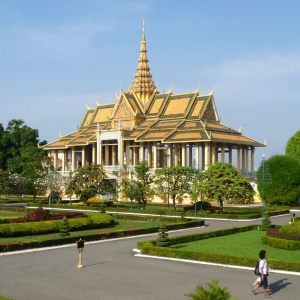 As Cambodia struggles to regain its footing as an independent nation, signs of empire still abound. French movie heartthrob Alain Delon smiles from sidewalk kiosk stands flogging his brand of filter-tip gaspers in packets of twenty. Though they are mostly too expensive for the average Khmer to buy a full pack, they are broken open and sold separately. There is a Champs Elyse Hotel, a Rue Pasteur and a grand Boulevard Charles de Gaulle. Mind you there is a Boulevard Chairman Mao Tse Tung and General Josip Tito as well. Past foreign influences are constant reminders of their chequered history. Phnom Penh city is spread on a grid of street numbers; odd numbered streets run East-West, even numbered streets run North South. This makes sense to people who live there but I challenge you to find Street 196. The government announced a new initiative for the nation’s capital to rename, re-number, and map every street and go-down in the city. The announcement was met with widespread apprehension. In some quarters fear. Since the destruction wrought by the Khmer Rouge little remains in the way of official documents and records. Survivors, people dislocated at the time, have rebuilt their lives and resettled. Many have changed their names and do not want to be located, especially if they were active participants of the former Khmer Rouge. Such is the level of inbuilt mistrust and fear; the locals are none too happy with the idea as they see it as another tool of exercising social control over the people. The same way the state-owned media operate.
As Cambodia struggles to regain its footing as an independent nation, signs of empire still abound. French movie heartthrob Alain Delon smiles from sidewalk kiosk stands flogging his brand of filter-tip gaspers in packets of twenty. Though they are mostly too expensive for the average Khmer to buy a full pack, they are broken open and sold separately. There is a Champs Elyse Hotel, a Rue Pasteur and a grand Boulevard Charles de Gaulle. Mind you there is a Boulevard Chairman Mao Tse Tung and General Josip Tito as well. Past foreign influences are constant reminders of their chequered history. Phnom Penh city is spread on a grid of street numbers; odd numbered streets run East-West, even numbered streets run North South. This makes sense to people who live there but I challenge you to find Street 196. The government announced a new initiative for the nation’s capital to rename, re-number, and map every street and go-down in the city. The announcement was met with widespread apprehension. In some quarters fear. Since the destruction wrought by the Khmer Rouge little remains in the way of official documents and records. Survivors, people dislocated at the time, have rebuilt their lives and resettled. Many have changed their names and do not want to be located, especially if they were active participants of the former Khmer Rouge. Such is the level of inbuilt mistrust and fear; the locals are none too happy with the idea as they see it as another tool of exercising social control over the people. The same way the state-owned media operate.
In the north of Cambodia is Seam Reap, the third largest city and the tourist heart of the nation. Here infrastructure develops rapidly to withstand the yearly influx of tourists clamouring to get themselves over the magnificent World Heritage listed temple complex colloquially known as Angkor Wat. Although that in itself is merely one exemplary temple among a larger area housing hundreds of Khmer temples. Temples both large and small from differing periods of a rich ancient history of the kingdom are now in various states of decay.
Further north in the remote dense jungle region of Rattanakiri Province near the Vietnam border is home to the “Cambodian Jungle Girl.” Purported to be Rochom P’ngieng, now 30 years old, she went missing herding water buffalo with her sister in 1989. She was first sighted again in 2007 sneaking into a village and stealing rice. Scuttling on all fours like a monkey and with no discernible language skills she was captured and reunited with her family who attempted to integrate her back into family life. She preferred to crawl, refused to wear clothes, and made several attempts to escape which she finally did. Disappearing back into the jungle again in May 2010. She has not been sighted since. Her father is saving for an offering of one wild ox, one pig, one chicken, and four jugs of wine for her safe return. Remote and dense, these forests have been home and hideaway for centuries. As recently as 2004 a pro Khmer Rouge tribe of 34 people emerged from the jungle where they’d been hiding since the regimes collapse in 1979.
In Phnom Penh skyscrapers are beginning to dot the cityscape. Largely out of place they provide a hint of confidence Khmer’s see in the emerging future. This in the heart of a city where the biggest attraction is S-21, Toul Sleng, the genocide museum on Street 113, a ghoulish and heartbreaking reminder of a not so distant past. A turbulent past that sits fresh in the lives of an expanding population still haunts the minds of three generations of gentle Khmer people.
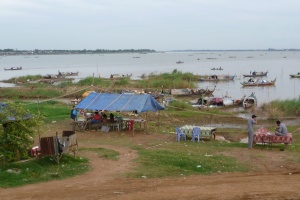 At the merge of the two powerful river sources another existence plays out, a place where politics is remote. Across from the city among the reeds and mud flats numbers of long, low canoe like river craft is home to the fishing families. It is mostly a Muslim community isolated and shunned by the mainstream population of Buddhist Khmers. They are the underclass, the non-people of Cambodia. On this neglected reach, where the river road finishes and runs to the river, makeshift structures have sprung up and dot the wedge of muddy land on the water’s edge. Open sided, rusty tin and thatch roofed places that house signs of lives lived off the water; beds, matting, tarpaulins, tables and plastic chairs, cooking utensils, pots and pans, even an electric fan. Closer observation shows electricity is sourced illegally off the main supply from the road above them. A network of wires run from structure to structure with the odd fluorescent tube attached. Small plots of land are under cultivation watered by the rise and fall of the river. A quick count shows there are over forty-two boats fishing the reach. Boats slide quietly into the rushes, the catch unloaded into orange eskies on the shore, then glide silently out again. Not till well after dark will these families call it a day.
At the merge of the two powerful river sources another existence plays out, a place where politics is remote. Across from the city among the reeds and mud flats numbers of long, low canoe like river craft is home to the fishing families. It is mostly a Muslim community isolated and shunned by the mainstream population of Buddhist Khmers. They are the underclass, the non-people of Cambodia. On this neglected reach, where the river road finishes and runs to the river, makeshift structures have sprung up and dot the wedge of muddy land on the water’s edge. Open sided, rusty tin and thatch roofed places that house signs of lives lived off the water; beds, matting, tarpaulins, tables and plastic chairs, cooking utensils, pots and pans, even an electric fan. Closer observation shows electricity is sourced illegally off the main supply from the road above them. A network of wires run from structure to structure with the odd fluorescent tube attached. Small plots of land are under cultivation watered by the rise and fall of the river. A quick count shows there are over forty-two boats fishing the reach. Boats slide quietly into the rushes, the catch unloaded into orange eskies on the shore, then glide silently out again. Not till well after dark will these families call it a day.
This city always seems to be at work and whether among the river’s reaches, the early signs of rising developmental modernism, or the historical body of broken buildings in a country overrun with broken politics, Khmers eke out their day to day existence. A struggle for survival where money is scarce and malnutrition endemic. Wonder of wonders they manage despite the odds. Today is January 7th. Flags are flying in the streets of Phnom Penn today. There is little evidence of celebration.



